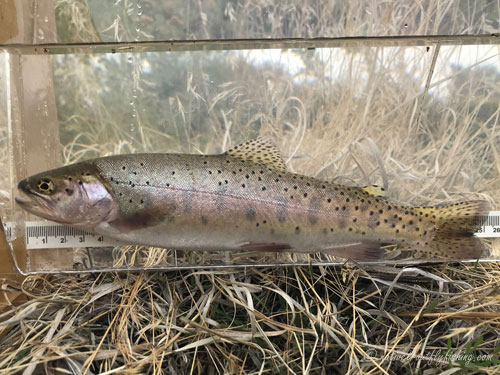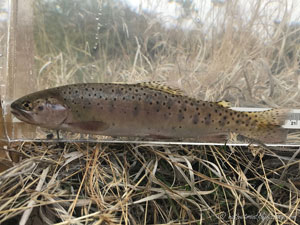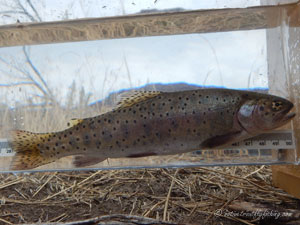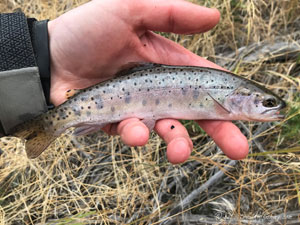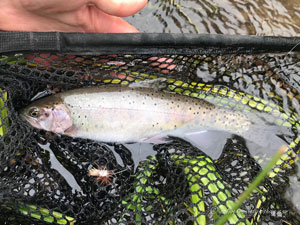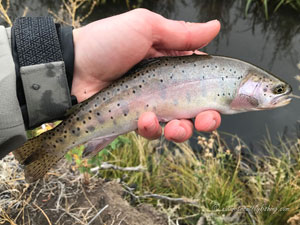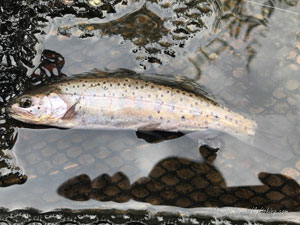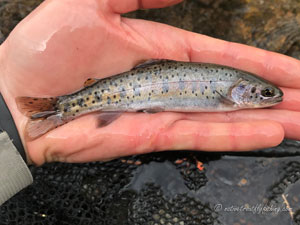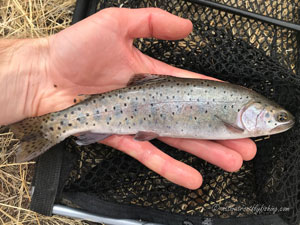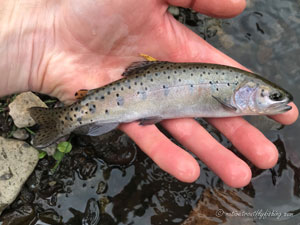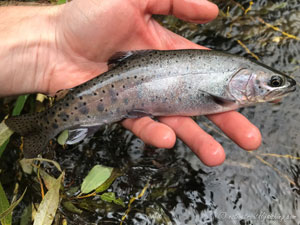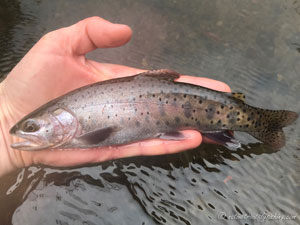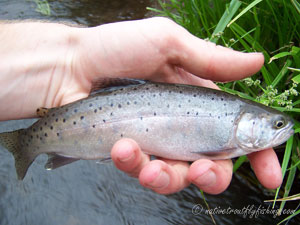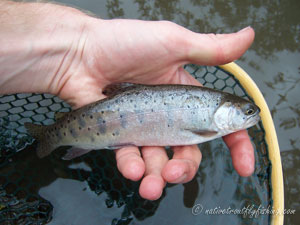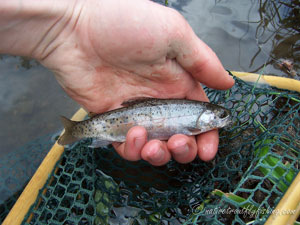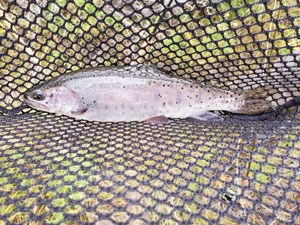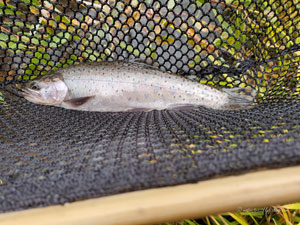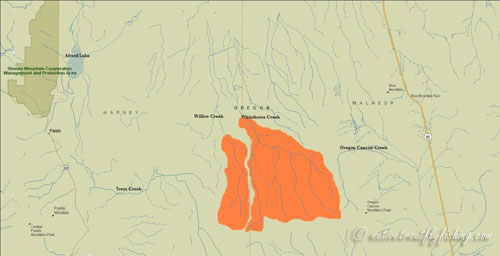Willow-Whitehorse Basin Cutthroat
Oncorhynchus henshawi ssp.
A cutthroat from a small stream in the Willow-Whitehorse Basin of southeastern Oregon.
Introduction
The Willow-Whitehorse or Coyote basin Cutthroat is considered a subspecies of Lahontan Cutthroat under a new classification system for Cutthroat trout proposed by Trotter et al. (2018) (previously a minor sub-species of Lahontan Cutthroat (Behnke 1992, Behnke 2002)). Genetic evidence indicates that Willow-Whitehorse Cutthroat are unique from all other forms of Lahontan Cutthroat (Peacock et al. 2010, Peacock et al. 2018), warranting their subspecies status. This trout is native to two small streams, Willow and Whitehorse Creeks, which flow from the Trout Creek Mountains in the southeastern Oregon desert. Behnke (1992) suggested that Willow-Whitehorse Cutthroat colonized the basin via a headwater transfer from the Quinn River basin; however, the basin may have been colonized from multiple sources (Peacock et al. 2018). During the cooler climate of the last ice age, the basin was filled by Coyote Lake, which the Cutthroat utilized. However, when the lake receded about 10,000 years ago due the shift to a dryer climate, these trout became isolated in Willow and Whitehorse Creeks. Today these streams flow through a remote, rugged, and arid region where daily water temperatures can reach the 80's °F (27 °C) and flows are often very unstable.
Life History Information
The Willow-Whitehorse basin Cutthroat are native to two small desert streams, and it is thought that they only exhibit a stream resident life history. However, no formal life history studies have been conducted and ODFW (2005) suggested that there might be a migratory fluvial component to the population. Like other varieties of trout living in an arid environment, Willow-Whitehorse Cutthroat have adapted to survive under extreme conditions and are able to withstand short periods at temperatures of 80 to 85 °F (26.5 to 29.5 °C) (Smith 1984; Dunham 1999). These fish are known to attain a maximum size of approximately 14" (35.5 cm) and average 6" to 10" (15 cm to 25.5 cm) (Behnke 2002, Trotter 2008) and have a diet consisting of aquatic and terrestrial insects. Size is correlated with elevation and the productivity of the stream reach and Jones et al. (1998) showed that age-one and older fish were significantly larger in lower elevation reaches. Adult fish favor beaver ponds and the outflows of the beaver dams, which provide cold-water refuges during periods of high summer water temperatures and are areas of stable overwintering habitat (Talabere 2002). It is thought that these fish reach sexual maturity at age-two and have a maximum age of between four and five years old (Behnke 2002). Spawning takes place during the spring once flows begin to subside, and the eggs develop quickly after being spawned. The extreme conditions of the basin appear to limit the survival of juvenile fish and recruitment tends to be best during wet years. During drought years, the range of these Cutthroat may become more restricted to the upper stream reaches.
Status
The Willow-Whitehorse Cutthroat’s restricted range and the extreme conditions of the Coyote basin put it at a particular risk of extinction. Fortunately, the populations of Cutthroat in the basin are relatively stable today due in large part to significant habitat protection effort and the establishment of several out of basin safe-net populations in the Steens Mountains in the Alvord Basin of Oregon. Non-native trout have never been introduced to Willow or Whitehorse creeks and as such these Cutthroat have been spared the threat of hybridization and competition with other species. However, over the past century habitat degradation has seriously threatened the viability of the Willow-Whitehorse basin Cutthroat populations.
The main cause of habitat degradation was due to poor grazing practices, which caused a wide variety of negative impacts to the watersheds. Grazing in the basin led to a loss of riparian vegetation directly due to over grazing, as wells due to intentional removal often via fire to “improve” grazing (Trotter 2008). This loss of riparian cover results in a reduction of cover from predators, an increase in water temperature and the destabilization of stream banks. Destabilized stream banks results in streams become incised and disconnected from their flood plains. This leaves streams most susceptible to flooding events, erosion, and increased sediment loads. In turn high sediment loads can smoother and suffocate trout eggs, greatly reducing juvenile recruitment. By 1989, long-term degradation of the watersheds reduced the populations to 8,000 fish and sparked the development of the Trout Creek Mountain Working Group. Since then, grazing in the basin has been conducted in a more ecologically sound manner, with grazing rotations, shorter grazing seasons, and less cattle in higher elevation areas. Additionally, a significant amount of the riparian corridor has been fenced to exclude cattle allowing vegetation to reestablish. Beaver activity in areas with recovered vegetation has also had a positive effect by storing water, which raises the water table and provides more stable flows of cool water. Beaver ponds also collect fine sediment and as they fill in can reconnect incised streams with their flood plains. By 1994 thanks in larger part to the habitat protection efforts, the population in the streams reached a high of approximately 40,000 fish (Jones et al. 1998).
While the habitat throughout the basin has improved significantly, climate change now looms as a major threat to the Willow-Whitehorse Cutthroat. A 2005 study showed that after a prolonged drought the population had dropped approximately 14,000 fish: the lowest levels since 1989 the (Gunkel and Jacobs 2005). In 2012, the Holloway Fire burned through 715 sq. miles (1,850 sq. km) including 85% of the Willow and Whitehorse watersheds and was followed by a period of prolonged drought from 2012 to 2015. This drought was one of the most severe on record and resulted in portions of the creeks in water temperatures that were ~ 3.5 to 7 °F (2 to 4 °C) above normal as well as some stretches of the creek going dry (Schultz et al. 2017). It is unclear the degree to which the drought and Holloway Fire impacted the Cutthroat populations in the basin, but such events underscore the fragile nature of these populations. While numbers of these fish continue to fluctuate in response to climate conditions and disasters such as fires, both the Willow and Whitehorse Creek populations have been deemed to be stable enough to permit catch and release fishing and with a couple of wet years it is hoped that the population will rebound once again.
Description
The coloration of the Willow-Whitehorse basin Cutthroat is typically a brownish-olive color on the back, transitioning to dull brassy or yellowish color along the sides. Fish may be rather silvery, especially during fall through early summer and they often display a rosy coloration along their lateral line. Parr marks are often retained into adulthood and are typically a purplish color. Willow-Whitehorse Cutthroat are sparsely spotted and have moderate to large spots distributed primarily above the lateral line and most concentrated towards the tail.
Stream Resident Form
Click on images to view a larger picture
Native Range
A map of the original native range of the Whitehorse Basin Cutthroat trout. Data Source: Behnke (2002) and Trotter (2008).
References
Behnke, R. J. 1992. Native trout of western North America. American Fisheries Society Monograph 6. American Fisheries Society, Bethesda, Maryland.
Behnke, R.J. 2002. Trout and Salmon of North America. Chanticleer Press, New York.
Dunham, J.B. 1999. Stream temperature criteria for Oregon's Lahontan cutthroat trout Oncorhynchus clarki henshawi. University of Nevada. Reno, Nevada.
Gunkel, S.L. and S.E. Jacobs. 2005. Population assessment of Lahontan cutthroat trout. Oregon Department of Fish and Wildlife, Salem, Oregon.
Jones, K.K., J.M. Dambacher, B.G. Lovatt, A.G. Talabere and W. Bowers. 1998. Status of Lahontan cutthroat trout in Coyote Lake Basin, Southeast Oregon. North American Journal of Fisheries Management 18: 308-317.
ODFW. 2005. Oregon native fish status report. Oregon Dept. of Fish and Wildlife, Salem, Oregon.
Peacock, M.M., M.L. Robinson, T. Walters, H.A. Mathewson and R. Perkins. 2010. The evolutionary significant unit concept and the role of translocated populations in preserving the genetic legacy of Lahontan cutthroat trout. Transactions of the American Fisheries Society 139: 382–395.
Peacock, M.M., H.M. Neville and A.J. Finger. 2018. The Lahontan basin evolutionary lineage of cutthroat trout. 2018. Pages 231–259. in P. Trotter, P. Bisson, L. Schultz and B. Roper editors. Cutthroat trout: evolutionary biology and taxonomy. American Fisheries Society Special Publication 36. American Fisheries Society. Bethesda, Maryland.
Schultz, L.D., M.P. Heck, D. Hockman-Wert, T. Allai, S. Wenger, N.A. Cook and J.B. Dunham. 2017. Spatial and temporal variability in the effects of wildfire and drought on thermal habitat for a desert trout. Journal of Arid Environments 145: 60-68.
Smith, R.H. 1984. Native trout of North America. Frank Amato Publications, Portland, Oregon.
Talabere, A.G. 2002. Influence of water temperatures and beaver ponds on Lahontan cutthroat trout in a high-desert stream, Southeastern Oregon. Master's Thesis, Oregon State University, Corvalis. 1-45.
Trotter, P. 2008. Cutthroat: Native Trout of the West. Second Edition. University of California Press, Berkley, California.
Trotter, P., P. Bisson, B. Roper, L. Schultz, C. Ferraris, G.R. Smith and R.F. Stearley. 2018. A special workshop on the taxonomy and evolutionary biology of cutthroat trout. Pages 1–31 in P. Trotter, P. Bisson, L. Schultz and B. Roper editors. Cutthroat trout: evolutionary biology and taxonomy. American Fisheries Society Special Publication 36. American Fisheries Society. Bethesda, Maryland.
Contact
Feel free to contact me if you have any questions or comments
Willow-Whitehorse Basin Cutthroat Trout Links
My Willow-Whitehorse Cutthroat Trips
Bureau of Land Management - Willow Creek Wilderness Study Area
Oregon Department of Fish and Wildlife - Lahontan Cutthroat
Native Trout Links
Truchas Mexicanas' - Native Trout of Mexico
Balkan Trout Restoration Group
Trout and Seasons of the Mountain Village - About Japanese Trout
Western Native Trout Challenge
California Heritage Trout Challenge
Fly Fishing Blogs
Dave B's Blog: Fly Fishing for Native Trout
The Search for Native Salmonids
Conservation Links
Western Native Trout Initiative
Fly Fishing Links
Fishing Art Links
Americanfishes.com - Joseph R. Tomelleri
Fish Eye Guy - Underwater Trout and Salmon Pictures
